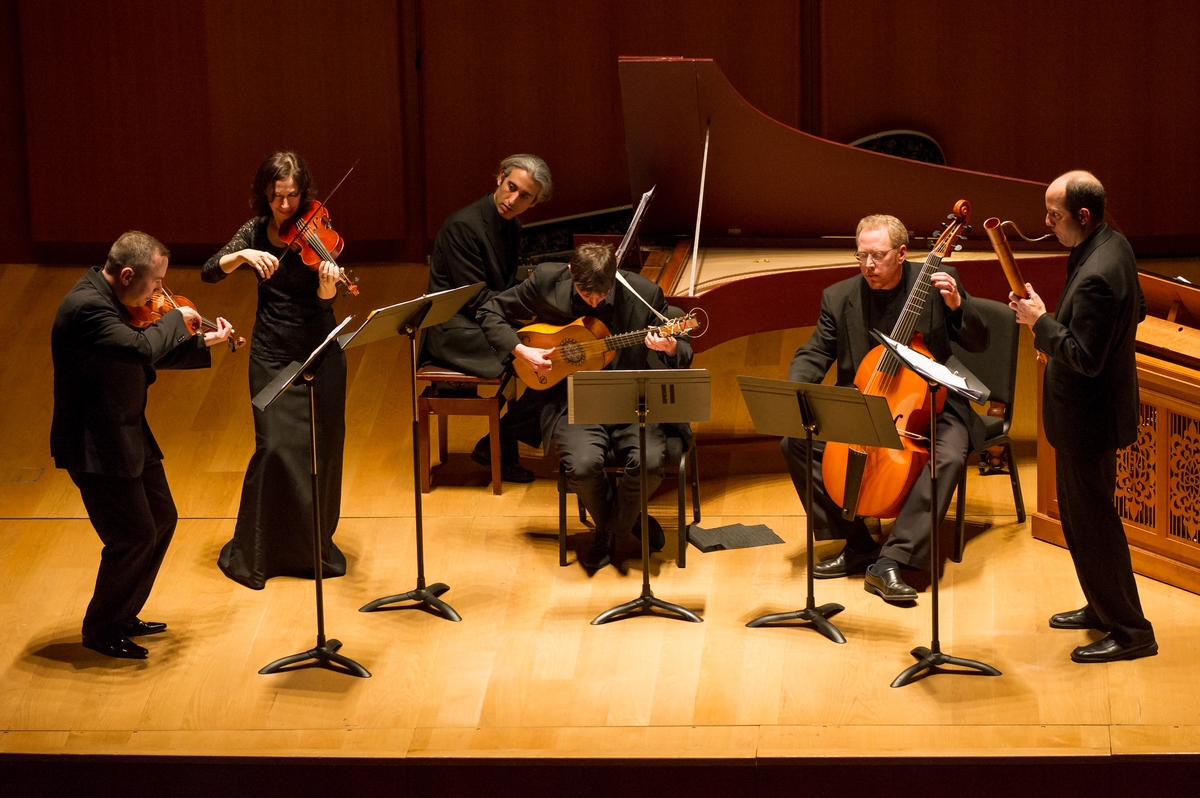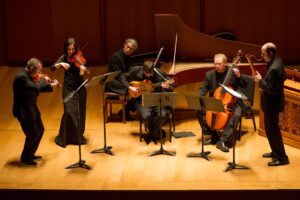Program: #19-06 Air Date: Jan 28, 2019
To listen to this show, you must first LOG IN. If you have already logged in, but you are still seeing this message, please SUBSCRIBE or UPGRADE your subscriber level today.
The baroque ensemble gives us “A Cabinet of Musical Curiosities from the Seventeenth Century,” the invention of the new musical style in Italy and Germany.
MB1800, a NYC institution, is the city’s longest-running series devoted exclusively to early music. Since the series’ inception, concerts have been presented at Corpus Christi Church in Morningside Heights, giving audiences a uniquely satisfying experience.
Louise Basbas is the founder and director of the series. The New Yorker praised MB1800, calling it “the essential series.” Time Out New York remarked: “The resonant acoustics of Corpus Christi Church will deliver you into your own personal solitude.... Few other venues can claim this fusion of strong programming and quality auditory surroundings.”
Music Before 1800 is made possible by the New York State Council on the Arts with the support of Governor Andrew Cuomo and the New York State Legislature. MB1800 is also supported, in part, by the New York City Department of Cultural Affairs in partnership with the City Council.
NOTE: The fifth in our series of concerts in the Music Before 1800 series features the ensemble Quicksilver. For more information: http://www.quicksilverbaroque.com/.
And very special thanks to Anderson Sound Recording for providing the audio for these concerts.

The idea of a “wonder-chamber,” a cabinet of curiosities, is one that vividly engaged the 17th-century imagination. In a time when science was emerging from magic, when the world was becoming mapped and known, when quirky and bizarre objects were things to be delighted in and relished, the Wunderkammer was something that every savant would have: a collection of unexpected, remarkable, and striking objects. This afternoon we present to you our own cabinet of delights, collected from the rich and strange music of the seventeenth century.
We open each half of our program with a remarkably inventive composer from the northern reaches of Germany. Matthias Weckmann studied with Heinrich Schütz in Dresden, from whom he received training in the latest Italian styles. He later became the director of music at the Jacobikirche in Hamburg, where he organized a series of weekly concerts with distinguished musicians who performed “the best things from Venice, Rome, Vienna, Munich, Dresden, etc.” Doubtless his own fiercely dramatic ensemble sonatas were heard among these foreign pieces; his Sonata no.9 has a particularly striking rhetorical organization.
One of the Italian composers Weckmann may well have presented on his series was Maurizio Cazzati, who spent his career in the northern Italian courts before becoming maestro di cappella at the important church of San Petronio in Bologna. During his time there, Cazzati turned the capella into a brilliant ensemble of thirty-five well-paid musicians, and created a large body of repertory for them where they could display their talents as soloists as well as members of a large ensemble. His sonatas are great examples of the mid-century Italian sonata in style, halfway between the experimentation of the early 1620s and the highly formalized movements of Corelli later in the century.
Several virtuoso Italian violinists sought refuge from the wars and plagues of mid-century Italy at the wealthy and prestigious Viennese court of the Holy Roman Empire. They brought with them the new idea of the sonata concertata, where each instrument steps forward to take a solo. Emperor Leopold I himself was an enthusiastic patron, particularly fond of these new arts of instrumental music, and he rewarded the talents of native-born composers. After playing for the Emperor several times, Biber became “von Biber” in recognition of his exemplary talents. The sonorous sonata a tre attributed to him not only allows each player to take a turn as soloist, but also brings everyone together in a particularly lyrical and expressive triple-time section at the close.
Many of our sonatas were written by musicians who themselves were expert performers. Michelagnolo Galilei was a virtuoso Florentine lutenist whose fame spread far enough that he was invited to become a court musician for the nobles of Poland when he was only eighteen. He later became a member of the Hofkapelle of Maximilian I in Munich, where he spent the rest of his life. Although his brother, the scientist Galileo Galilei, is better-known today, Michelagnolo was a composer whose works circulated widely throughout Germany and Italy. He published one volume of engraved music for ten-course lute, a collection of toccatas and dances which (as one scholar has remarked) “express their author’s elegance of invention, cosmopolitanism of style and eminently poetic nature.”
The heartfelt opening of the Sonata a 3 by Andreas Oswald is very much in the high17th-century ensemble sonata style. Oswald died at the relatively young age of thirty, after a career spent as a church organist in Weimar and Eisenach, two places that would later become associated with J.S. Bach. Most of Oswald’s ensemble music is preserved in the Ludwig Partiturbuch, an anthology prepared by the Gotha musician Johann Ludwig as a present for the highly intellectual Duke Anton Ulrich of Braunschweig.
Another composer who turns up in the Partiturbuch is the north German composer David Pohle, another student of Schütz. Much of Pohle’s work is lost, including a large cantata cycle he composed between 1663 and 1664. The one cantata that does survive is tantalizing in its rich harmonies and strong sense of melody. Some of Pohle’s work also turns up in a collection ostensibly by Antonio Bertali; the second volume of Prothimia suavissima seems to have been an attempt by the publisher to capitalize on the name-recognition of Bertali by adding a number of works by others. Thanks to the detective work of scholars like our own Julie Andrijeski, many of these pieces have been restored to their original composers, like this strongly rhetorical sonata.
We close each half of our concert with works by one of our favorite composers, Dario Castello. It is remarkable that a figure who created some of the most striking flights of 17th-century musical imagination should leave no biographical trace. We don’t know when he was born, when he died, or where he worked. On the title-page of his two collections of sonatas, he is described as the “head of the wind group” at San Marco; if so, he certainly knew Monteverdi there. All that we know of him today emerges from his sonatas, which (unusually for the time), were often copied and reprinted—proof that his contemporaries thought they were something special. His Sonata decimaterza is a work which starts in the great tradition of the renaissance canzona with a lively subject and answer that is worked out among all four obbligato instruments. But then he begins to try out radical new ideas of ensemble writing—the wordless rhetoric of a recitative, the sudden transformation into a triple-time dance, or a passionate dialogue—a musical rhetoric that is, in a word, “quicksilver.”
After another ferociously inventive sonata by Matthias Weckmann, we hear from one of the most celebrated court violinists of the 17th century, Marco Uccellini, who was the director of music for the d’Estes in Modena. Uccellini is credited with publishing the first collection of sonatas solely for violin and continuo (Op. 5), many of which include virtuosic passagework that explore high positions and distant keys. His Op. 4 collection of Sonate, Correnti, et Arie contains not only light dances (essentially, party music) but more substantial and searching sonatas like the Sonata detta La Angela. Who was Angela? We don’t know; these titles are often tributes to patrons or friends.
The flood of sonatas printed in Venice in the early part of the 17th century began to decline in the 1630s, partially because of a terrible outbreak of plague which swept Northern Italy. One of the victims of “the voracity of this
pestilence” (according to the preface of his sonatas) was the great virtuoso violinist G.B. Fontana, whose works were gathered together after his death. His Sonata decimaquarta is characteristic in its almost visionary sweetness, as well as in its seemingly effortless spontaneity of gesture, with some unexpectedly wayward rhythms.
Another great musical talent whose career was cut short by the plague was Johann Schmeltzer, who was celebrated by a contemporary as “the famous and perhaps the most distinguished violinist in all of Europe.” Schmeltzer spent much of his career providing entertainments for Emperor Leopold I, which could range from ballets to elaborate sonatas like the one for violin, trombone, bassoon, and continuo we hear today. He became the first non-Italian to attain the rank of Kapellmeister at the Imperial court in 1679. He didn’t live to enjoy the honor, however: a few months later, he was dead from an outbreak of plague.
We hear a piece from a slightly later generation with the Prelude, Fugue, and Postlude of Georg Böhm. This important composer, who was to influence J.S. Bach so deeply, spent his formative musical years in Hamburg where he would have heard French-style opera at the public opera house as well as organ music in the grand German tradition represented by older masters like Reincken. Böhm himself became the organist for nearby Lüneburg in 1697 and held the position until his death. Böhm’s three-movement keyboard work we hear today brings together the French elegance and sense of dance that Böhm would have learned in Hamburg with the deep harmonic intensity characteristic of the north German keyboard tradition.
Several virtuoso Italian violinists sought refuge from the wars and plagues of mid-century Italy at the wealthy and prestigious Viennese court of the Holy Roman Empire. One of these migrants was Antonio Bertali, who arrived in Vienna around 1624 and became Kapellmeister to the Emperor in 1649. His Sonata a 3, with a heartfelt adagio that frames a truly rocking ciaconna, is a striking example of his highly theatrical style. It turns up in an important collection of music assembled by Gustav Düben in Uppsala, Sweden, for use by the court there — another sign of how far and wide this music traveled across Europe.
We end with Castello’s striking Sonata decimaquarta, from his second book of sonatas. This work begins with a little epigram, a statement and its answer, which is then discussed by the ensemble at length. After several unexpected rhetorical adventures, the sonata finishes with a grand eleven-bar pedal point, over which the upper voices sketch some wonderfully warped melodic phrases. In his preface, Castello recommends trying these pieces out once or twice before performing them, “for nothing is hard to those who love it.”
—Robert Mealy
- 01. . Matthias Weckmann (1616-1674): Sonata no.9 a 4 6:55
- 02. Maurizio Cazzati (1616-1678): Sonata sesta á 3 4:09
- 03. Heinrich Ignaz Franz von Biber (1644-1704): Sonata a 3 8:07
- 04. Michelagnolo Galilei (1575-1631): Toccata 8:02
- 06. David Pohle (1624-1695): Sonata no.12 a 4 6:17
- 07. Dario Castello (1602-1631): Sonata decimaterza 8:07
- 08. Matthias Weckmann: Sonata no.7 a 4 4:59
- 09. Marco Uccelini (1603-1680): Sonata decima sesta detta La Angela 4:31
- 10. Giovanni Battista Fontana (1589-1630): Sonata decimaquarta 6:58
- 11. Johann Schmelzer (c.1623-1680): Sonata a 3 6:35
- 12. Georg Böhm (1661-1733): Prelude, Fugue, and Postlude in G minor 6:27
- 13. Antonio Bertali (1605-1669): Sonata a 3 in A minor 5:14
Composer Info
Matthias Weckmann (1616-1674), Maurizio Cazzati (1616-1678), Heinrich Ignaz Franz von Biber (1644-1704), Michelagnolo Galilei (1575-1631), David Pohle (1624-1695), Dario Castello (1602-1631), Marco Uccelini (1603-1680), Giovanni Battista Fontana (1589-1630), Johann Schmelzer (c.1623-1680), Georg Böhm (1661-1733), Antonio Bertali (1605-1669)
